As someone who considers herself handy in the kitchen, this has been one of the most interesting (unusual?) recipes I’ve ever followed. Mostly because until yesterday I had never heard of cornmeal pudding. In fact, when I was approached by the moderators of this blog to see if I would be interested in evaluating the recipe, my first response after glancing at the ingredient list was “Oh no, they wrote cornmeal, not corn starch!” As you can imagine, I was initially apprehensive about the success of this dish.
But I’m willing to be proven wrong, and I consider myself a bit of a savant when it comes to homemade puddings, thanks in large part to the wisdom of Maya Angelou’s cookbook, The Welcome Kitchen. There are few things more comforting than a nice, warm pudding on a rainy afternoon, so I set to work.
 I first preheated the oven to 300 degrees, and then began the pudding by scalding 5 cups of milk in a medium saucepan, a step designed to help to milk mix smoothly with the cornmeal. Because I don’t have a double boiler, I worked over a low heat to avoid burning the pudding.
I first preheated the oven to 300 degrees, and then began the pudding by scalding 5 cups of milk in a medium saucepan, a step designed to help to milk mix smoothly with the cornmeal. Because I don’t have a double boiler, I worked over a low heat to avoid burning the pudding.
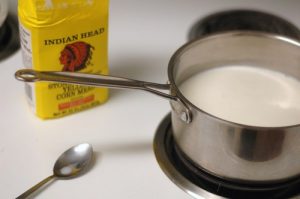
When small bubbles began to appear in the milk (but before it boiled) I added the corn meal into the warmed milk.
If a little voice in your head at this point is screaming “No, no, don’t add the corn meal into the milk! It will clump!” someone in your life taught you well. Although I knew better, I did it anyway.

Please learn from my mistake: Do not pour the cornmeal directly into the milk. Instead, mix a small amount of the warmed milk (about 1/2-1 cups) into the 1/2 cup of cornmeal in a separate bowl. Mix it in gradually, continually stirring, until you have a soupy mixture. Then add this cornmeal “soup” back into the saucepan of milk, constantly stirring. This will help to create a smooth, consistent pudding.
 I next cooked this down for about 20 minutes over low heat, stirring regularly but not constantly.
I next cooked this down for about 20 minutes over low heat, stirring regularly but not constantly.
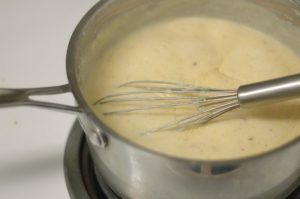 I was pleasantly surprised at this stage, with how much the pudding actually resembled… well… pudding! Having always worked with cornstarch previously, I had an image in my mind of cornmeal pudding turning out more like grits- gritty and textured- and I simply couldn’t imagine a pudding like that being something I could enjoy. Nothing could have been further from the truth, however! While this pudding didn’t quite have the silky smoothness I normally associate with pudding, it was not gritty or coarse at all. The larger grains gave the pudding a heartier, denser, more stick-to-your-ribs feel than any pudding I’ve ever made, and I also noticed that the cornmeal was significantly easier to work with, vs. cornstarch. Once properly mixed (milk added to meal, not meal added to milk), it bound the pudding together quickly and without too much cajoling.
I was pleasantly surprised at this stage, with how much the pudding actually resembled… well… pudding! Having always worked with cornstarch previously, I had an image in my mind of cornmeal pudding turning out more like grits- gritty and textured- and I simply couldn’t imagine a pudding like that being something I could enjoy. Nothing could have been further from the truth, however! While this pudding didn’t quite have the silky smoothness I normally associate with pudding, it was not gritty or coarse at all. The larger grains gave the pudding a heartier, denser, more stick-to-your-ribs feel than any pudding I’ve ever made, and I also noticed that the cornmeal was significantly easier to work with, vs. cornstarch. Once properly mixed (milk added to meal, not meal added to milk), it bound the pudding together quickly and without too much cajoling.
Once it had reached a thickness I liked, I removed it from heat and added in 1/2 cup of molasses…

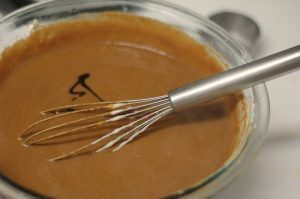
…and cinnamon, ginger, nutmeg, and salt to taste. The recipe recommends 1/2 tsp of each spice, but I went slightly overboard on cinnamon and nutmeg because I like fragrant holiday dishes.

I then spooned it into a greased, covered baking dish, and popped it into the oven to bake for 2 hours.
While my pudding was getting nice and bubbly, I worked on the fruit component of the recipe. I chose two fruits in season: cranberries and raspberries. The cranberries I cooked down into a compote with a little bit of sugar (to cut the bitterness) and then added the fresh raspberries to keep their fresh vibrancy.

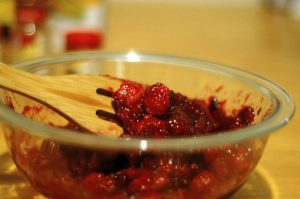 In retrospect, I think that fresh bosc pears would be a fantastic complement to this pudding, although my choices were the epitome of holiday flavors.
In retrospect, I think that fresh bosc pears would be a fantastic complement to this pudding, although my choices were the epitome of holiday flavors.
The final product:
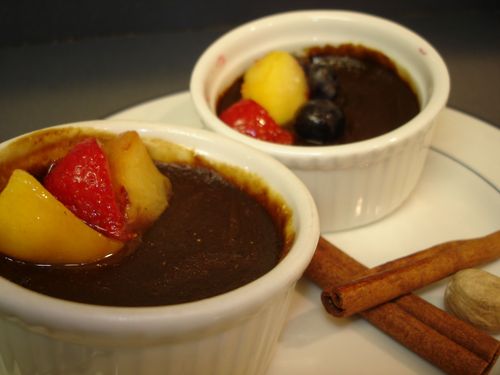
Here’s the recipe and nutrition info for New England Pudding. Enjoy.
Ali Sims is a Supporter Services Representative with AICR and owner of Heliantha Photography. She has spent many years working in various health-related fields, and enjoys finding creative ways to make dishes that are both healthy and full of flavor. You can follow her on Tumblr at helianthaphotography.tumblr.com or visit her website at helianthaphotography.com.





